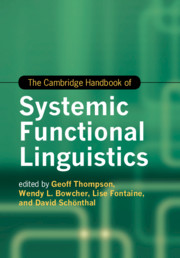Book contents
- The Cambridge Handbook of Systemic Functional Linguistics
- Cambridge Handbooks in Language and Linguistics
- The Cambridge Handbook of Systemic Functional Linguistics
- Copyright page
- Dedication
- Contents
- Figures
- Tables
- Contributors
- Preface
- Acknowledgements
- Introduction
- Part I SFL: The Model
- 1 Firth and the Origins of Systemic Functional Linguistics
- 2 Key Terms in the SFL Model
- 3 Semantics
- 4 The Clause
- 5 The Rooms of the House
- 6 Context and Register
- 7 Intonation
- 8 Continuing Issues in SFL
- 9 The Cardiff Model of Functional Syntax
- 10 SFL in Context
- Part II Discourse Analysis within SFL
- Part III SFL in Application
- Index
- References
10 - SFL in Context
from Part I - SFL: The Model
Published online by Cambridge University Press: 03 May 2019
- The Cambridge Handbook of Systemic Functional Linguistics
- Cambridge Handbooks in Language and Linguistics
- The Cambridge Handbook of Systemic Functional Linguistics
- Copyright page
- Dedication
- Contents
- Figures
- Tables
- Contributors
- Preface
- Acknowledgements
- Introduction
- Part I SFL: The Model
- 1 Firth and the Origins of Systemic Functional Linguistics
- 2 Key Terms in the SFL Model
- 3 Semantics
- 4 The Clause
- 5 The Rooms of the House
- 6 Context and Register
- 7 Intonation
- 8 Continuing Issues in SFL
- 9 The Cardiff Model of Functional Syntax
- 10 SFL in Context
- Part II Discourse Analysis within SFL
- Part III SFL in Application
- Index
- References
Summary
Information
- Type
- Chapter
- Information
- The Cambridge Handbook of Systemic Functional Linguistics , pp. 259 - 282Publisher: Cambridge University PressPrint publication year: 2019
References
Accessibility standard: Unknown
Why this information is here
This section outlines the accessibility features of this content - including support for screen readers, full keyboard navigation and high-contrast display options. This may not be relevant for you.Accessibility Information
- 1
- Cited by
